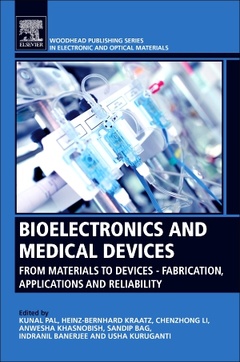Description
Bioelectronics and Medical Devices
From Materials to Devices - Fabrication, Applications and Reliability
Woodhead Publishing Series in Electronic and Optical Materials Series
Coordinators: Pal Kunal, Kraatz Heinz-Bernhard, Khasnobish Anwesha, Bag Sandip, Banerjee Indranil, Kuruganti Usha
Language: English
Subjects for Bioelectronics and Medical Devices:
1006 p. · 15x22.8 cm · Paperback
Description
/li>Contents
/li>Readership
/li>Biography
/li>Comment
/li>
Bioelectronics and Medical Devices: From Materials to Devices-Fabrication, Applications and Reliability reviews the latest research on electronic devices used in the healthcare sector, from materials, to applications, including biosensors, rehabilitation devices, drug delivery devices, and devices based on wireless technology. This information is presented from the unique interdisciplinary perspective of the editors and contributors, all with materials science, biomedical engineering, physics, and chemistry backgrounds. Each applicable chapter includes a discussion of these devices, from materials and fabrication, to reliability and technology applications. Case studies, future research directions and recommendations for additional readings are also included.
The book addresses hot topics, such as the latest, state-of the-art biosensing devices that have the ability for early detection of life-threatening diseases, such as tuberculosis, HIV and cancer. It covers rehabilitation devices and advancements, such as the devices that could be utilized by advanced-stage ALS patients to improve their interactions with the environment. In addition, electronic controlled delivery systems are reviewed, including those that are based on artificial intelligences.
1. Light-fidelity based biosignal transmission2. Development of a low-cost color sensor for biomedical applications3. Development of a voice-controlled home automation system for the differently-abled4. Lab-on-a-chip sensing devices for biomedical applications5. Impedance-based biosensors6. Acoustophoresis-based biomedical device applications7. Electroencephalography and near-infrared spectroscopy-based hybrid biomarker for brain imaging8. Micro-electro-mechanical system9. Enzyme-based biosensors10. Ultrasound-based drug delivery systems11. Electroencephalogram-controlled assistive devices12. Electromyogram-controlled assistive devices13. Electrical safety14. Biomedical metrology15. Bone-implantable devices for drug delivery applications16. Iontophoretic drug delivery systems17. Microneedle platform for biomedical applications18. Trends in point-of-care microscopy19. Development of spectroscopy-based medical devices for disease diagnosis in low resource point-of-care setting20. Dielectrophoresis-based devices for cell patterning21. Multichannel surface electromyography22. Sensors for monitoring workplace health 23. Advances in enzyme-based electrochemical sensors: current trends, benefits, and constraints24. Electrocardiogram signal processing-based diagnostics: applications of wavelet transform25. Sensor fusion and control techniques for biorehabilitation26. Biofunctional interfaces for cell culture in microfluidic devices27. Microsystems technology for high-throughput single-cell sorting28. Microfluidic devices for DNA amplification29. Optimizing glucose sensing for diabetes monitoring30. Brain control to neurofeedback in rehabilitation31. Motor imagery classification enhancement with concurrent implementation of spatial filtration and modified stockwell transform32. A hybrid wireless electroencephalography network based on the IEEE 802.11 and IEEE 802.15.4 standards33. Deep learning in medical and surgical instruments34. Electroencephalogram-based brain systems for controlling rehabilitative devices35. A system for automatic cardiac arrhythmia recognition using electrocardiogram signal36. Designing of a biopotential amplifier for the acquisition and processing of subvocal electromyography signals
Materials Scientists and Engineers, biomedical engineers, chemists, physicists, product designers
Dr. Kraatz studied chemistry at the Universities of Düsseldorf and the University of Kent in Canterbury and obtained his PhD in 1993 at the University of Calgary. In 2011, accepting a position at the University of Toronto, where he is a full professor in chemistry and currently serves as Vice-Principal Research at the University of Toronto Scarborough. He has served as Director of the Nanofabrication Facility at Western and as Chair of the Department of Physical and Environmental Sciences at U of T. Awards and recognitions include the Canada Research Chair in Biomaterials, the PetroCanada Young Innovator Award, the Award in Pure or Applied Inorganic Chemistry from the Canadian Society for Chemistry, and the Principal’s Research Award. Bernie’s research interests are at the interface of inorganic chemistry and electrochemistry, focusing on the design of bioconjugates for sensing applications, surface-supported functional bioconjugates, and bio(nano)materials. He has published more than 250 peer-reviewed papers and two books.
Dr. Khasnobish is currently employed as a Research Scientist at TATA Consultancy Services (TCS) Innovation Lab, Kolkata, India, where she is actively doing research in cognitive neuroscience, tele-rehabilitation, stress analysis from physiological signals, electrooculography and eye tracking. She completed her graduation and post-graduation in Biomedical Engineering. She completed her Ph. D. in Engineering in the field of “Human- Computer interface based devices for biomedical applications from Jadavpur Univer
- Presents the latest topics, including MEMS-based fabrication of biomedical sensors, Internet of Things, certification of medical and drug delivery devices, and electrical safety considerations
- Presents the interdisciplinary perspective of materials scientists, biomedical engineers, physicists and chemists on biomedical electronic devices
- Features systematic coverage in each chapter, including recent advancements in the field, case studies, future research directions, and recommendations for additional readings
These books may interest you

Wearable Bioelectronics 193.44 €

Advanced Bioelectronic Materials 235.69 €

Graphene Bioelectronics 143.27 €

